The perennial winners of the Champions League and Division 1 Feminine are known for their attacking flair and offensive efficiency. However, their defensive work has been overlooked despite the team using some interesting tactics to shut out the opposition. This is the first in a series of analysis articles to examine the offensive and defensive philosophy and structure of Olympique Lyonnais Féminin. The team houses four of the world’s best defenders and two world-class defensive midfielders, making it interesting to see how they integrate them, as well as the tactical adjustments Jean-Luc Vasseur has made since he took over from Reynold Pedros. I did an analysis on Lyon in our Total Football Analysis June 2019 Magazine edition, and I thought it was time for a refresh, especially given the changes.
The first part will cover their defensive ideologies and how they use different tactical techniques through tactical analysis. I will analyse their strengths and identify the key areas that make them defensively strong. Data has become an important addition to tactical analysis and scout reports, making data analysis a necessity to analyse their defensive performances. We will rank Lyon against other top European sides and see where they stand. This will enable us to understand their tactical setup better.
Olympique Lyonnais Féminin Data Analysis
For this analysis, we will use data across the domestic and European competitions the teams have participated in. Due to the data available, I have used data from this season’s Champions League only to measure challenge intensity, except for Chelsea, whose figures have been taken from their domestic campaign.

When analysing any defensive metrics, it’s important to understand the pressing nature of a side, and to do this we will analyse Lyon’s PPDA (passes per defensive action) against top European sides. This will help us distinguish between heavy, energetic, pressing sides against the ones that prefer to sit back and defend. The higher the value, the less a team presses.
This could also give us an insight into Lyon’s defensive style and why it’s been so effective. This first graph includes teams from the top four European leagues, including Arsenal, Chelsea, Manchester City, Wolfsburg, Bayern Munich, Barcelona, Atletico Madrid, and Paris Saint-Germain. Comparing Lyon against arguably the best teams in women’s football is a strong comparison, and the results speak for themselves. Lyon have the lowest PPDA at 5.10 and close behind is PSG with 5.14. It’s staggering to see both French sides possess the lowest PPDA of these European sides.
What does this mean? This means Lyon seems to have adopted a high-intensity pressing strategy to regain possession of opposing teams. With other teams seemingly taking a bit more time to initiate a defensive action to retain possession, Lyon are much quicker. This could suggest a high press, however, there are many factors that could point towards this high PPDA which we’ll discuss further in the analysis.
We also want to examine challenge intensity to understand and quantify Lyon’s defensive actions. Challenge intensity will tell us how many defensive actions a team engages in per minute of opposition possession. This should give us a clearer image of Lyon’s intensity and will to win the ball back actively. The higher the value, the more intense a team is in their challenges.

The graph gives us some interesting results. While the results of the PPDA were conclusive, given that the two French sides had the best record, the challenge intensity results are closer. PSG are clear winners with a rating of 8.30, meaning they are a very aggressive side off the ball and want to win back possession very quickly. Lyon sit third in this category with 7.60, behind Bayern Munich who have a rating of 7.80. What this translates to is that Lyon aren’t as intense in their challenges as PSG and Bayern Munich when it comes to putting in a challenge.
Just analysing these results alone is not an indicator of a team’s style, but rather requires quantifiable analysis to bring context to these numbers. There are reasons behind a low PPDA and slightly higher challenge intensity score, however, what this does do is give us a basis to understand the team’s defensive style and intensity when looking at the footage to further analyse their defensive philosophy and structure.
Olympique Lyonnais Féminin Defensive shapes
Lyon have been pretty faithful to their 4-2-3-1 formation since Vasseur’s arrival. They’ve used this system for 77% of the season, rarely opting for another formation. They’ve occasionally used a 4-1-4-1 and a 4-4-2, but rarely does that come into play. They rely on their superiority in possession to ensure they keep the opposition as far away from their goal as possible.
The 4-2-3-1 comprises of two ball-playing centre-backs, two flying full-backs, two all-action defensive midfielders, a creative attacking number 10, two energetic wingers, and one striker. The most important position is that of the two defensive midfielders who are tasked with keeping the balance and shape of the team, regardless of how it changes. However, each position plays a vital role in the overall balance and working of the system. Understanding the out-of-possession defending shape gives us the foundation to Lyon’s defensive structure. I will explain the two out-of-possession shapes Lyon utilises in the defensive phase that occur under different circumstances.
The first involves Lyon setting up in a 4-4-2, which is triggered once the opposition starts playing out from the back. The attacking midfielder often joins the striker to create the two up front, probing the opposition defenders into trying to play around them and force long balls where the aerially proficient Wendie Renard can battle for possession. The main objective is to ensure Lyon maintain horizontal compactness in the central areas. The two wide players sit slightly narrower to ensure central compactness. The team rotates together towards the side the ball is on, prompting the wingers and full-backs to press if the ball goes down the flanks. This ensures that wherever the opposition decides to build out from, Lyon are covered. The front two will not engage in a heavy press but rather remain close enough to make their presence felt. The hard graft is done by those further back in midfield. If the forwards feel as though the opposition are lingering on the ball too much, they then begin to press to force the tempo. Lyon wants to dictate the game's tempo with or without the ball.
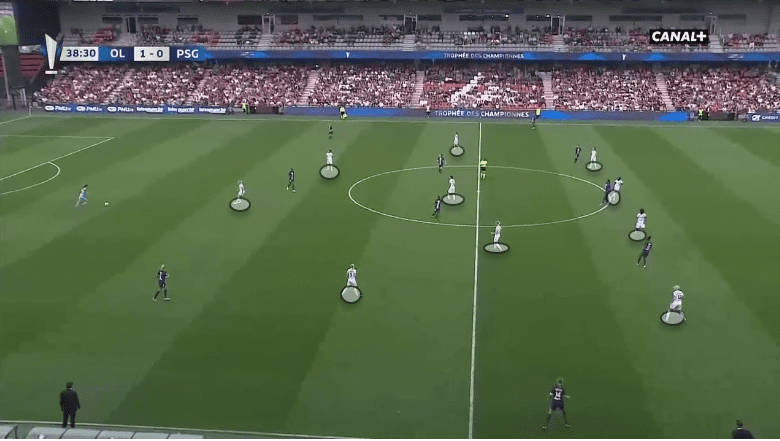
The image above shows Lyon’s out-of-possession shape, which was explained above. Notice the shorter gaps between each bank of four, where they do not want to give Paris Saint-Germain’s three forwards time and space to operate. PSG’s main striker and right wide forward are central players, so Lyon’s narrow back four would negate this. While the two PSG full-backs are free, both Alex Greenwood/Selma Bacha and Lucy Bronze can press the wide areas while support arrives in the form of the wingers or midfielders.
When playing passes through midfield, Lyon creates superiority in the midfield and defence by morphing into a 3-4-1-2 / 3-4-3 shape. The team do not want to be in a situation where they become overrun in either third, thus they create horizontal compactness through positional rotations. While the main objective remains the same, this shape aids their pressing strategy. The 4-4-2 is used to hold shape and dictate the opposition’s movement. The 3-4-1-2 allows Lyon to press intensely in midfield through their midfielders and full-backs. Alternatively, the 3-4-1-2 shape also caters to counter-attacking and creating passing lanes. Still, it also allows them to utilise the pace from the full-backs to cover for Renard’s lack of pace, whether they move wide or centrally, due to the high line they hold.
The full-backs have a tactical role in the side, each tasked with their own individual roles. By default, one full-back will play slightly higher and wider whilst the other tucks into a narrower position. Bronze, the right-back, is usually the one who plays a more defensive role, acting as a third midfielder/central defender, mirroring Kyle Walker’s role at Manchester City. From here, Bronze can drive inside to press the interior ball carrier or move outside to pressure the opposition and Lyon’s winger.
As the graphic below illustrates, Lyon are able to keep the central areas compact and shift towards the side of the ball. If the ball shifts into the highlighted central area, then up to three players will move in to help press and close the player down. There is a constant movement with the #6 moving across to cover for the #8 while the attacking midfielder (#10) drops into cover #6’s movement. This illustration also depicts Lyon’s desire for compactness and overloads in midfield and defence. If teams succeed in bypassing the press, it gives Lyon enough time to move into position to defend against crosses if it comes to it.
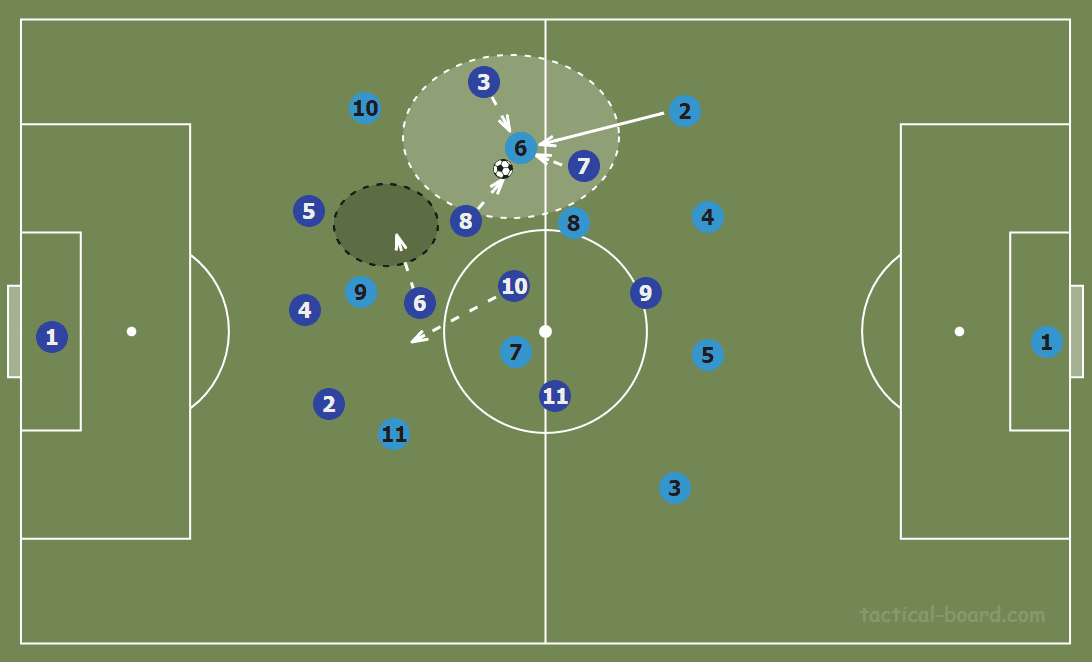
Positional rotations
One of the key themes under Vasseur has been the use of positional rotations to ensure there is enough defensive cover. Lyon’s entire structure and the system is predicated on using positional rotations and players understanding the system inside and out. The concept is simple – players interchange positions to gain superiority in certain areas of the field to ensure no gaps are left around the pitch. Under their predecessor, Pedros, the concept was very much a key component to his style of play and has continued under Vasseur.
So, how does this integrate into Lyon’s defensive strategy? The core fundamental philosophy mainly concerns the two defensive midfielders and full-backs. These players are critical to the way Lyon positions and moves across the pitch to ensure they gain superiority.
The two midfielders position themselves in such a way that they are always parallel to each other, regardless of their position. On the ball, one player will remain in a more advanced position while the other will take up a more defensive stance. This allows the midfielder to fill in at full-back or centre-back when either player vacates their position (in the case of the full-back moving up to press or hold a higher position). The defensive midfielders require superior positional intelligence and understanding to play the role. One example revolves around defensive awareness. When the opposition move closer to the 18-yard box, one of the midfielders will slot in between the centre-backs to create an extra body at the back while the full-backs take up their customary wide positions. This is where Lyon have enough bodies in the box to contend with any crosses into the area. Other times, the midfielders will observe and react to vacant positions and slot in to provide cover.
The full-backs are equally important in this system, and shades of Pep Guardiola’s influence can also be seen here. Both Bronze and Greenwood/Bacha are tasked with their own instructions to be part of these positional rotations to aid in the defensive strategy. One full-back is much more aggressive and plays an attacking role by being positioned slightly higher, often the left-back. The right-back will join in attacks if play progresses down the right. However, the player will often remain in a more defensive position, playing as a faux centre-back and midfielder.
Part of Lyon’s philosophy is to gain numerical superiority in every third when defending, making the player’s movement between midfield and defence vital. Bronze is an excellent defender with an even better tactical mind, and her ability to seamlessly move between the thirds adapting to the situation is what makes the role work well.
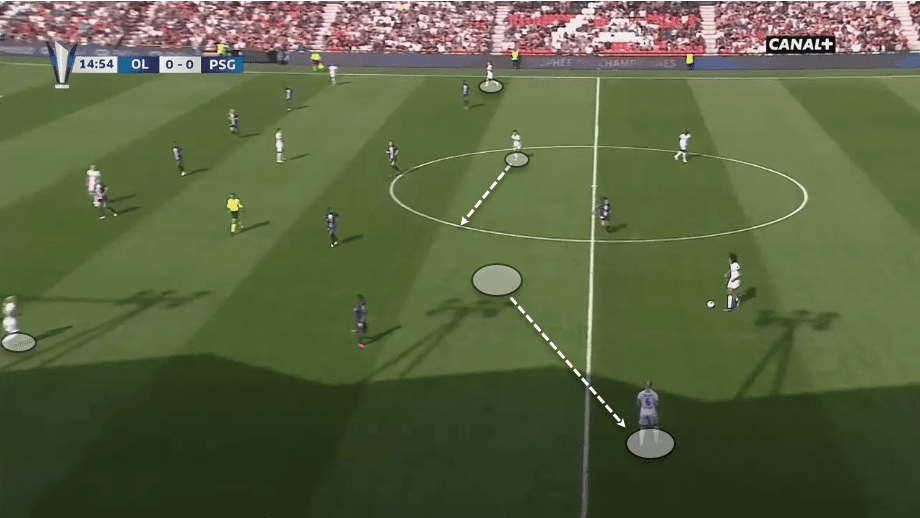
In this image, we can see Lyon recycle possession after recovering the ball in midfield. While this isn’t a defensive situation, we can see Amandine Henry situated in the left-back slot as Greenwood sits further forward. When Renard releases the ball forward, the three players will tuck in slightly to create a base. Simultaneously, Saki Kumagai will move into the vacant space to create a passing option and move closer to Henry’s position to rotate or fill in as an extra defender in case of a PSG counterattack.
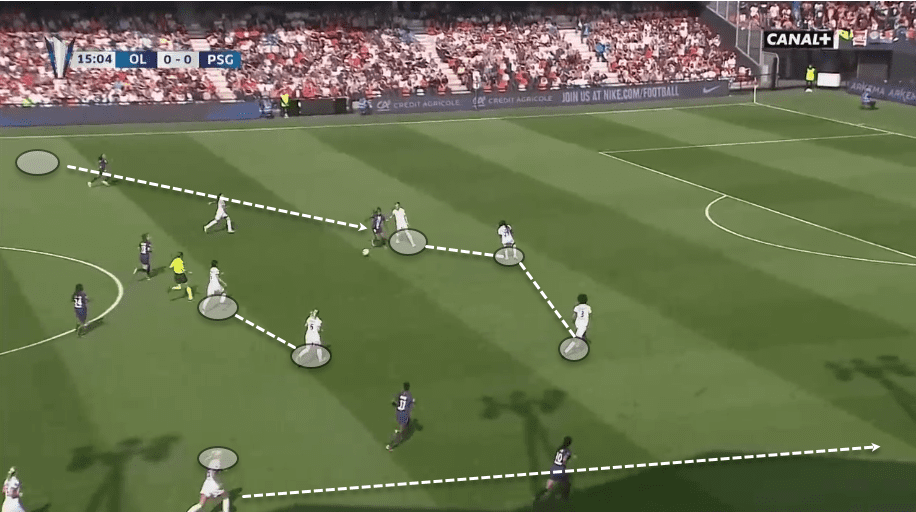
In the same phase of play, Renard’s pass is intercepted, which puts PSG in a favourable attacking situation. This triggers Lyon into packing numbers around the ball carrier and receiver, but what is also prevalent is the positional rotations occurring again. Henry had quickly moved back into midfield, with Kumagai dropping alongside her. Greenwood is sprinting back to cover at left-back, while Bronze makes her way back from a higher position on the right to become the third centre-back and disrupt Marie Antoinette Katoto from receiving the ball.
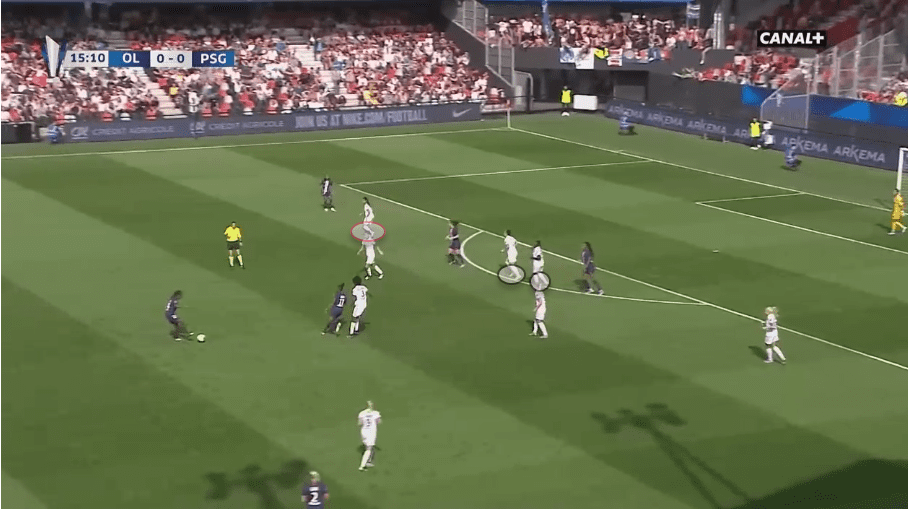
In the first image, PSG were in a favourable counter-attacking situation but by this point, Lyon have been able to gain defensive superiority. Renard pushes out to press Kadidiatou Diani with Henry filling in at centre-back. Amel Majri (red) has dropped in to take up Bronze’s position who, in turn, has moved in to become a centre-back. They have now closed all obvious passing routes for PSG, with a good chance to retain possession. This example has shown how the full-backs and defensive midfielders seamlessly interchange positions in moments to prevent a dangerous attacking situation. This now transitions us into Lyon’s pressing strategy and how they aim to win back possession in these situations and more.
Olympique Lyonnais Féminin Pressing structure
Earlier in this analysis, we looked at PPDA and how that signified a team’s pressing strategy. We understood that Lyon have the lowest PPDA of the top European teams, and that suggests they have a high pressing strategy. There are a couple of factors that can be attributed to this. Lyon’s out-of-possession 4-4-2 shape is the primary reason for their ability to establish a low PPDA. Holding a firm shape gives the opposition a limited number of passing options, forcing them to play long or direct into midfield. In doing so, Lyon are able to quickly activate their press once possession moves into midfield, leveraging their advantage of numbers in the area. Opponents average 16.57% long passes when playing against Lyon. Secondly, teams that play against Lyon average 2.41 passes per possession, which means for every moment they have possession, they make up to two passes. This suggests Lyon have a very aggressive style of play.
Tying this in with their challenge intensity rating, this metric can also be attributed to the fact that teams are moving the ball from defence to attack more directly into a place where Lyon are most comfortable winning back possession.
Now, diving into the tactics, Lyon’s pressing strategy revolves around a midfield press. The team isn’t too concerned with pressing from the front because teams will not always play out from the back, but rather play a couple of passes before playing direct. The only time the forwards get involved in a high press is when the opposition wins back the ball around their own box and passes it back to the goalkeeper.
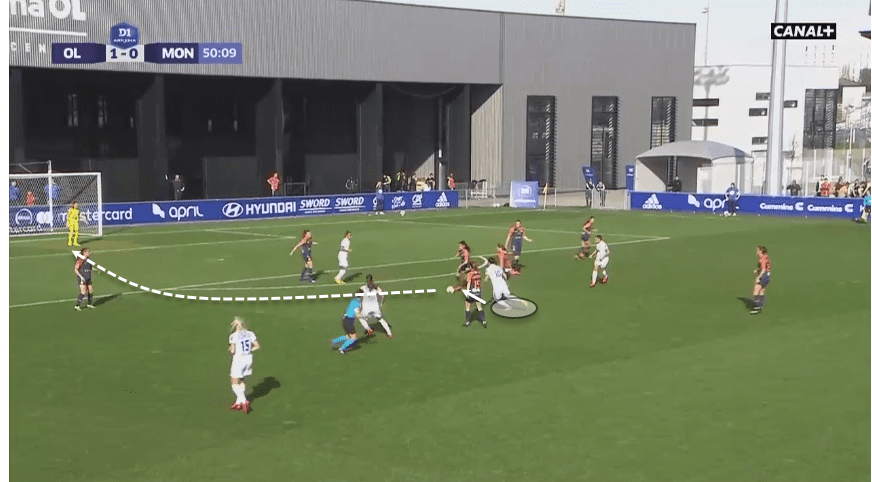
Montpellier wins the ball back near their box, and we can see how Dzsenifer Marozsán immediately starts pressing the ball carrier. It’s interesting to see how many Lyon players were committed to the attack, and one advantage of this is if Lyon does lose possession, they once again have numbers in that third to contribute to the press. Marozsán continues to press even when the ball is played back to the goalkeeper, who then launches the ball into midfield, where Lyon’s central midfielders pounce. This sequence has already shown us how Montpellier have played a minimal number of passes before it’s allowed Lyon to win it back on their terms in a packed midfield.
Revisiting the overloads in midfield, the reason for having one full-back tucked in and the other high and wide is to allow Lyon the ability to adapt to the ball’s position when it transitions from the opposition’s defensive to middle third. The right-back, Bronze, is usually positioned narrowly to provide the extra defensive assuredness. As we’ve mentioned earlier, when play reaches midfield, this triggers Lyon’s midfield to start pressing first through the closest player, often Henry or Kumagai. Occasionally, Marozsán, Majri, or Bronze will be present to start the press in midfield.
There are usually two to three players near the ball-carrier to engage in a heavily pressured pressing system. The idea is to force the opposition into a misplaced pass or win back possession through a tackle or interception. The two defensive midfielders are vital to the way Lyon operates both on and off the ball.
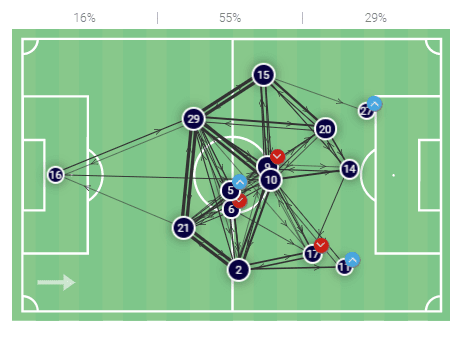
Looking at the average positions on the map above, we can see how Lyon are shaped. The defensive midfielders are in close proximity to be able to protect the back line or forwards. The right full-back Bronze (#2), situated slightly narrower with Kumagai (#5) or Henry (#6), can drop in between the centre-backs to ensure that there is cover on all sides. The left-back, Greenwood (#15) provides width and would aid in pressing higher up her side.
We see this in practice below, where Montpellier are looking to build an attack through the middle. Note the positioning of the players in the first image: Renard, Griedge Mbock, Kumagai, and Greenwood (out of frame) make up a back four, with Majri, Henry, Bronze, and Delphine Cascarino in midfield. Bronze (circled) cuts inside and is the first to press the midfielder. The positioning of the pivot (Henry) will aid the press if the ball carrier manages to move into her zone. Each player in the first image is either man-marking or can cover an area.
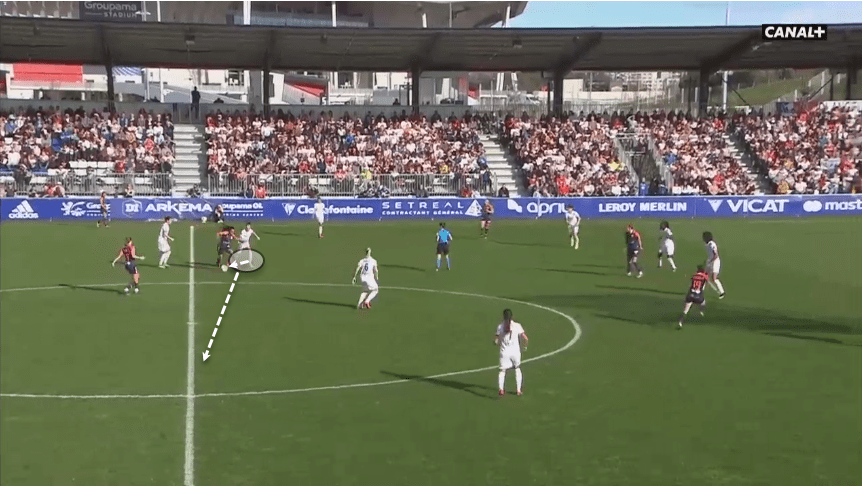
Continuing the same move, the ball is circulated to the other midfielder, prompting Majri to start pressing and attempt to retain higher possession. Henry continues to patrol her area by following the run to cover the midfielder's run and attempt to intercept a possible pass.
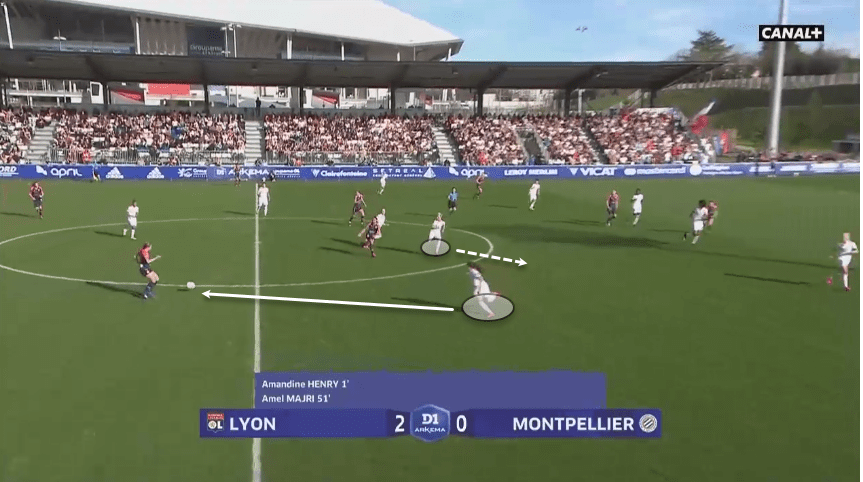
To complete the move, the pass from the ball carrier in the previous image was intended for the runner, which prompts Renard to step forward and intercept the pass. Renard can move out of position because her centre-back partner, Mbock, follows her marker across, and Henry can move into the space left behind.
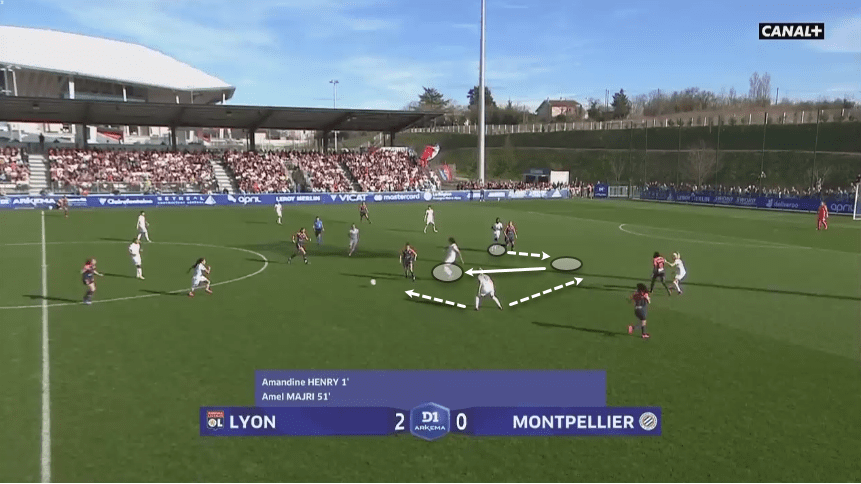
Ultimately, Lyon does have an aggressive pressing system when teams enter the midfield area. We’ve seen Paris Saint-Germain try to bypass this in their games against Lyon this season. The pass map comparison below is from a league game that saw Paris switch to a back five with the full-backs as the primary outlet, chiefly Hanna Glas (#2). Lyon reacted with slightly deeper full-backs and one defensive midfielder sitting close to the centre-halves to negate the barrage of crosses.
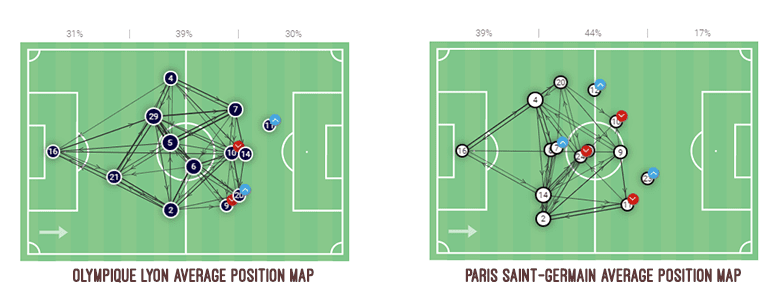
However, due to Lyon’s ability to rotate and positionally rotate, they were able to intercept many of PSG’s passes and crosses in the half-spaces, as the interceptions plot suggests. Bronze, in particular, made 13, while Henry and Kumagai contributed 8 each. For a deeper understanding of the roles of full-backs in different systems, I have written an analysis in our March magazine, which included Bronze and Glas as two main case studies.
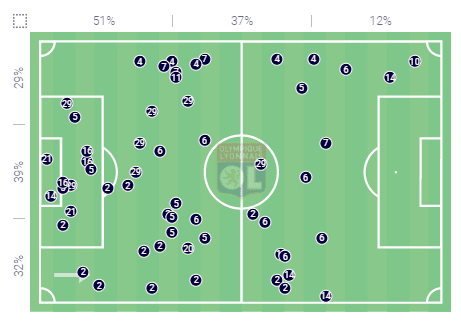
Conclusion
Lyon’s defensive work has not received the same amount of plaudits so far, with much of the attention given to their electrifying attack. Having only conceded four goals this season, their defensive work deserves much more credit than has been given. While they boast world-class defenders such as Renard, Bronze, Mbock, their effective and seamless integration into Vasseur’s tactics has been excellent. The tactical flexibility of Bronze is a particular highlight – being able to interchange from attacking right-back to a third central defender in a back three in a matter of moments.
When analysing the defensive structure of any team, it’s easy to focus on the defenders. However, Lyon’s two central midfielders have proven to be extremely important to the overall system and allow the team to function efficiently and effectively in both an offensive and defensive capacity. We saw examples of their importance through positional rotations and pressing by being at the right place to cover the possible space the ball carrier will move into.
Top teams often press high to win back possession and pressure opposition defences. Still, as we’ve seen through this analysis, Lyon is most effective when play moves into midfield, where their intensity and work rate increase close to the PPDA and challenge intensity statistics we discussed earlier.
The return of the Champions League will be a great test for the team and their defensive resolve against a stubborn Bayern Munich side. If we consider their previous Champions League wins, they should be likely winners for this season’s crown too.

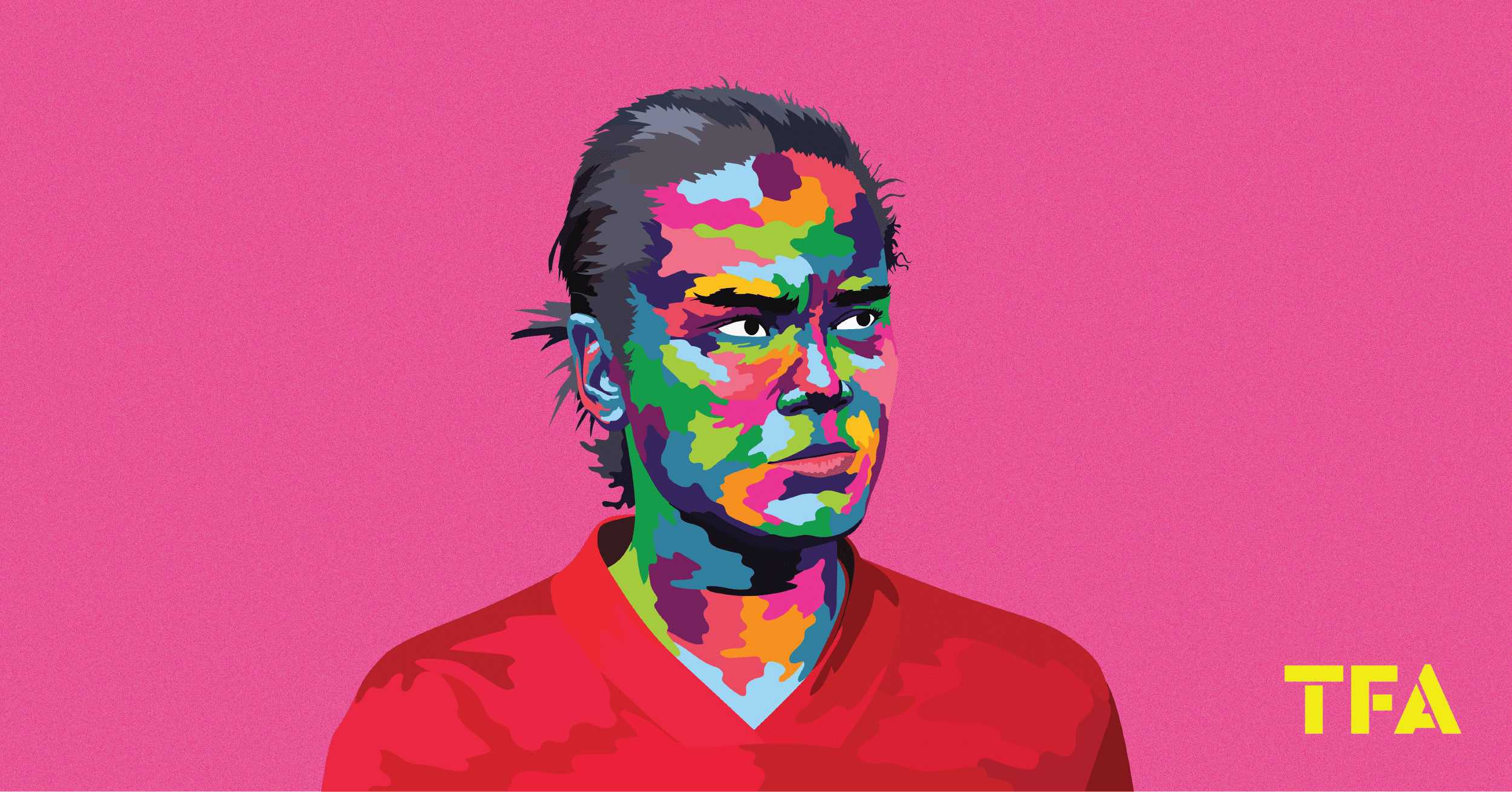




Comments